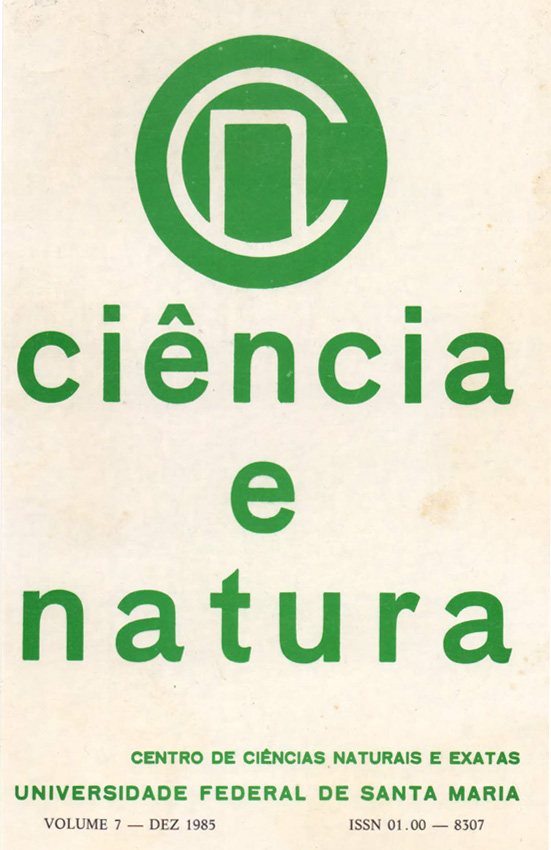Wood Anatomy of Mimosa cruenta Benth., (Leguminosae Himosoideae)
DOI:
https://doi.org/10.5902/2179460X25409Keywords:
Wood Anatomy, Mimosa cruenta Benth., Leguminosae Mimosoideae.Abstract
The general, macroscopic and microscopic anatomical characteristics of the secondary xylem of Mimosa cruenta Benth. are described. Quantitative and stereological data, as well as photomicrographs of the wood, are also furnished. The anatomical structure is analysed based on Wood Taxonomy, characteristics that permit the inclusion of the species in the Stipellares Benth. Series of the Mimosa L. genus being recognized.
Downloads
References
BARETTA-KUIPPERS, T. Wood anatomy of Leguminosae - its relevance to Taxonomy. In: POLHILL, R.M.& RAVEN, P.H. Advances in Legume Systematics. Kew, Procc. of the International Legume Conference, 1978. V. 11: 677-705.
BENTHM, G. Leguminosae III. Mimoseae. In: MARTIUS, C.F.P. de. Flora Brasiliensis, 1876. 15(2): 259-527.
BURKART, A. Las leguminosas argentinas silvestres y cultivadas. Buenos Aires, ACME Agency, 1952. 569 p.
BURKART, A. Leguminosae. In: PARODI, L.R. Enciclopedia Argentina de Agricultura y Jardineria. Buenos Aires, ACME S.A.C. I., 1959. v 1:.443-512.
BURKART, A. Leguminosas•Mimosoideas. Flora Ilustrada catarinense, 1979. 299 p.
COMISSÃO PANAMERICANA DE NORMAS TÉCNICAS. Descrição macroscópica, microscópica e geral da madeira - esquema I de recomendação. Colômbia, 1973. 19 p. (COPANT 30).
COZZO, D. Anatomia del leño secundario de las Leguminosas Mimosoideas y Caesalpinoideas argentinas silvestres y cultivadas. Rev. Inst. Nac. Invest. C. Naturales C. bot ., 2(2): 63-290,1951.
IFJU, G. Quantitative wood anatomy – a stereological approach. Blacksburg, VPI/IPT, 1977. 26 p.
LOMBARDO, A. Flora arborea y arborescente del Uruguay.Montevideo, Concejo Departamental, s/d . 151 p.
MARCHIORI, J.N.C. Estudo anatômico do xilema secundário e da casca de algumas espécies dos gêneros Acacia e Mimosa, nativas no Estado do Rio Grande do Sul. Curitiba, UFPr, 1980. 186f. Tese de Mestrado.
MARCHIORI, J.N.C. A estrutura do xilema secundário de Mimosa da Leoides Benth. (Leguminosae Mimosoideae).Ciência e Natura (4): 107-113, 1982.
METCALFE, C.R. & CHALK, L. Anatomy of the Dicotyledons. Oxford, Clarendon Press, 1972. 1500 p.
RAMBO, B. Leguminosae Riograndenses. São Leopoldo, Instituto Anchietano de Pesquisas. Bol. Nº 23, 1966. 166 p.
RECORD, S.J. & HESS, R.W. Timbers of the New World. New Haven, Yale University Press, 1949. 640 p.
Downloads
Published
How to Cite
Issue
Section
License
To access the DECLARATION AND TRANSFER OF COPYRIGHT AUTHOR’S DECLARATION AND COPYRIGHT LICENSE click here.
Ethical Guidelines for Journal Publication
The Ciência e Natura journal is committed to ensuring ethics in publication and quality of articles.
Conformance to standards of ethical behavior is therefore expected of all parties involved: Authors, Editors, Reviewers, and the Publisher.
In particular,
Authors: Authors should present an objective discussion of the significance of research work as well as sufficient detail and references to permit others to replicate the experiments. Fraudulent or knowingly inaccurate statements constitute unethical behavior and are unacceptable. Review Articles should also be objective, comprehensive, and accurate accounts of the state of the art. The Authors should ensure that their work is entirely original works, and if the work and/or words of others have been used, this has been appropriately acknowledged. Plagiarism in all its forms constitutes unethical publishing behavior and is unacceptable. Submitting the same manuscript to more than one journal concurrently constitutes unethical publishing behavior and is unacceptable. Authors should not submit articles describing essentially the same research to more than one journal. The corresponding Author should ensure that there is a full consensus of all Co-authors in approving the final version of the paper and its submission for publication.
Editors: Editors should evaluate manuscripts exclusively on the basis of their academic merit. An Editor must not use unpublished information in the editor's own research without the express written consent of the Author. Editors should take reasonable responsive measures when ethical complaints have been presented concerning a submitted manuscript or published paper.
Reviewers: Any manuscripts received for review must be treated as confidential documents. Privileged information or ideas obtained through peer review must be kept confidential and not used for personal advantage. Reviewers should be conducted objectively, and observations should be formulated clearly with supporting arguments, so that Authors can use them for improving the paper. Any selected Reviewer who feels unqualified to review the research reported in a manuscript or knows that its prompt review will be impossible should notify the Editor and excuse himself from the review process. Reviewers should not consider manuscripts in which they have conflicts of interest resulting from competitive, collaborative, or other relationships or connections with any of the authors, companies, or institutions connected to the papers.






